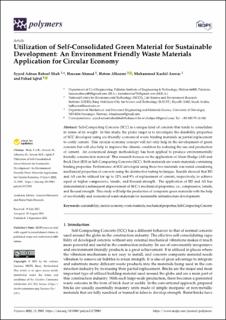| dc.contributor.author | Shah, Syyed Adnan Raheel | |
| dc.contributor.author | Ahmad, Hassam | |
| dc.contributor.author | Alhazmi, Hatem | |
| dc.contributor.author | Anwar, Muhammad Kashif | |
| dc.contributor.author | Iqbal, Fahad | |
| dc.date.accessioned | 2021-10-11T13:17:00Z | |
| dc.date.available | 2021-10-11T13:17:00Z | |
| dc.date.created | 2021-09-22T11:57:59Z | |
| dc.date.issued | 2021-09 | |
| dc.identifier.citation | Utilization of self-consolidated green material for sustainable development: An environment friendly waste materials application for circular economy. Polymers, 13 (17), 2985. | en_US |
| dc.identifier.issn | 2073-4360 | |
| dc.identifier.uri | https://hdl.handle.net/11250/2789071 | |
| dc.description.abstract | Self-Compacting Concrete (SCC) is a unique kind of concrete that tends to consolidate in terms of its weight. In this study, the prime target is to investigate the durability properties of SCC developed using eco-friendly economical waste binding materials as partial replacement to costly cement. This circular economy concept will not only help in the development of green concrete but will also help to improve the climatic condition by reducing the use and production of cement. An economical design methodology has been applied to produce environmentally friendly construction material. This research focuses on the application of Alum Sludge (AS) and Brick Dust (BD) in Self-Compacting Concrete (SCC). Both materials are waste materials containing binding properties. Performance of SCC developed using these two materials was tested considering mechanical properties of concrete using the destructive testing technique. Results showed that BD and AS can be utilized for up to 12% and 9% of replacement of cement, respectively, to achieve equal or higher compressive, tensile, and flexural strength. The application of BD and AS has demonstrated a subsequent improvement of SCC’s mechanical properties, i.e., compressive, tensile, and flexural strength. This study will help the production of composite green materials with the help of eco-friendly and economical waste materials for sustainable infrastructure development. | en_US |
| dc.language.iso | eng | en_US |
| dc.publisher | MDPI | en_US |
| dc.rights | Navngivelse 4.0 Internasjonal | * |
| dc.rights.uri | http://creativecommons.org/licenses/by/4.0/deed.no | * |
| dc.subject | polymer | en_US |
| dc.subject | grønne materialer | en_US |
| dc.subject | sirkeløkonomi | en_US |
| dc.subject | konstruksjoner og materialer | en_US |
| dc.title | Utilization of self-consolidated green material for sustainable development: An environment friendly waste materials application for circular economy | en_US |
| dc.type | Peer reviewed | en_US |
| dc.type | Journal article | en_US |
| dc.description.version | publishedVersion | en_US |
| dc.rights.holder | © 2021 by the authors | en_US |
| dc.subject.nsi | VDP::Teknologi: 500 | en_US |
| dc.source.volume | 13 | en_US |
| dc.source.journal | Polymers | en_US |
| dc.source.issue | 17 | en_US |
| dc.identifier.doi | 10.3390/polym13172985 | |
| dc.identifier.cristin | 1937070 | |
| dc.source.articlenumber | 2985 | en_US |
| cristin.ispublished | true | |
| cristin.fulltext | original | |
| cristin.qualitycode | 1 | |

